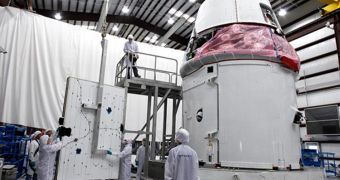Officials from the Space Exploration Technologies Corporation (SpaceX) say that the upcoming flight to be conducted by the Dragon space capsule to the International Space Station will feature deployable solar arrays attached to the spacecraft for the very first time.
Granted, the upcoming flight will only be the second to be carried out using Dragon, and only the third spaceflight as a whole for the company. Still, the addition of these arrays is a major milestone in developing a variant of the Dragon that can carry astronauts to low-Earth orbit (LEO),
Under the new space vision created by the Obama Administration for NASA, the space agency needs to dedicate its resources to putting astronauts on Mars and a near-Earth asteroid by 2035. In order to do that, it has to contract LEO-bound flights to private companies.
NASA is therefore financing four companies, under the Commercial Orbital Transportation Services (COTS) program. SpaceX is one of these companies, and the main beneficiary of the monetary aid.
The company is also the farthest advanced in achieving its objective, considering that it already sent its new Falcon 9 delivery system to space twice. The rocket was created to launch satellites by itself as well, but primarily to carry the Dragon to space.
In December 2010, the two flew together for the first time. The capsule was injected in a correct orbit around the planet, where investigators conducted a series of tests meant to see of the Dragon would behave under the circumstances it was built to face.
The spacecraft performed admirably, and managed to splash down in the Pacific Ocean without any harm, after completing only a handful of orbits. This made SpaceX the third entity in history to manage such a feat.
Now, NASA has given SpaceX permission to try and dock to the International Space Station in early February. In order to do that, the capsule has to be in space for prolonged periods of time, and therefore needs more electricity.
The solar panels installed on Dragon, which can be seen in the video below, generate just enough electricity to power up some 80 standard light bulbs. Most spacecraft heading to the ISS unfurl their solar panels within the first few minutes after reaching orbit.
The 5,000 watts of power the panels will generate should be enough to take the supply-laden Dragon to its correct docking port on the station. This will be the first time ever the space lab is visited by a private capsule.
The combination between battery packs and solar panels that Dragon uses is extremely efficient at keeping the spacecraft going, which is why scientists are considering using it for space missions as well, SpaceRef reports.

 14 DAY TRIAL //
14 DAY TRIAL // 